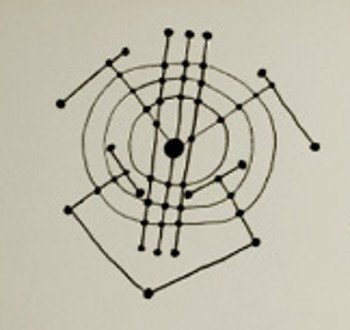 |
 |
Forward to November of 2015. I continued to research the drawings and found that many were scattered among different websites, but at least one, the PicassoLive.ru website contained all 16 plates. Further research found Lynn Becker’s blog covering the Picasso and Chicago exhibition and offered similar observations I had plus background on the drawings and their possible relationship to the 1928 wireframe sculpture Picasso proposed for the memorial to his late friend, the poet Guillaume Apollinaire. More research found the 2004 web piece by Peter Read written for the official Picasso Administration website. Read discusses "These are lyrical and fluid variations on the shape of the guitar, with dots and lines inspired by astronomical charts displaying the constellations" and "dot-and-line graphic style as a potential template for a monument to Apollinaire". With this background, I selected one of the images as a prototype from Plate C and started to develop software tools that could translate the 2D image into lines; a simple trace did that. The next step was to separate the different graphics elements of the image; circles and lines. Strategies were explored of how to express the 2D image in 3D. The first concept was to simply to extrude or place each graphic element at differing elevations and then connect them vertically or horizontally. The goal was to always make sure that the plan view of the 3D model was exactly the same as the original 2D image. Automated procedures were next developed to place a 3D sphere at each intersection or node, and connect each set of nodes with a 3D pipe. As you can see by the models displayed below, there is a great variety of possibilities of where the different graphic elements of circles and lines can be placed. The simple wireframe models, made of pipes and nodes exhibit a simple architectural identifiable form. Scale could easily be increased to represent floor and planes for full-scaled versions. After a number of explorations, finally by November of 2016, the initial set of models were ready to 3D print. Approximate dimensions of the 3D printed black plastic models: 4.5" x 4" x 0.75" References: ArchitectureChicago PLUS Blog by Lynn Becker: Pablo's Wireframes: The Architecture of Picasso's Dots and Lines A reproduction of the complete set of Picasso's illustrations, 16 plates can be found at: PicassoLive.ru Painting as a Site of Cultural Memory: Picasso's The Kitchen Peter Read, University of St. Andrews, Scotland, 2004, written for the official Picasso Administration website: Picasso's The Kitchen |
 |
Plates A and B |
 |
Plates C and D |
 |
Plates E and F |
 |
Selection from Plate C |
Model 00 3D Printed Black Plastic |
Model 01 3D Printed Black Plastic |
Model 02 3D Printed Black Plastic |
Model 05 3D Printed Black Plastic |
Model 07 3D Printed Black Plastic |
Model 08 3D Printed Black Plastic |
Model 09 3D Printed Black Plastic |
Model 10 3D Printed Black Plastic |
Model 11 3D Printed Black Plastic |